Compiled by: Zen, PANews
Introduction
With the recent explosive growth and popularization of artificial intelligence, many people have put forward different arguments about the intersection of artificial intelligence and cryptocurrency. These innovations have the potential to completely change various aspects of our digital lives, from managing digital assets to protecting intellectual property and combating fraud. It is worth noting that this fusion has sparked two prominent trends:
The integration of artificial intelligence with blockchain infrastructure, such as Render ($RNDR), Akash ($AKT), or Fetch.ai ($FET).
The emergence of protocols incentivizing machine learning intelligence production, such as Bittensor ($TAO).
Previously, AI applications on the blockchain were mainly focused on infrastructure, achieving AI/ML (artificial intelligence/machine learning) model storage and GPU leasing. This has led to trends such as token-incentivized reinforcement learning, zero-knowledge machine learning (zkML), and blockchain-based identity registration to address deepfakes. Meanwhile, a parallel trend is flourishing: incentivizing intelligent protocols.
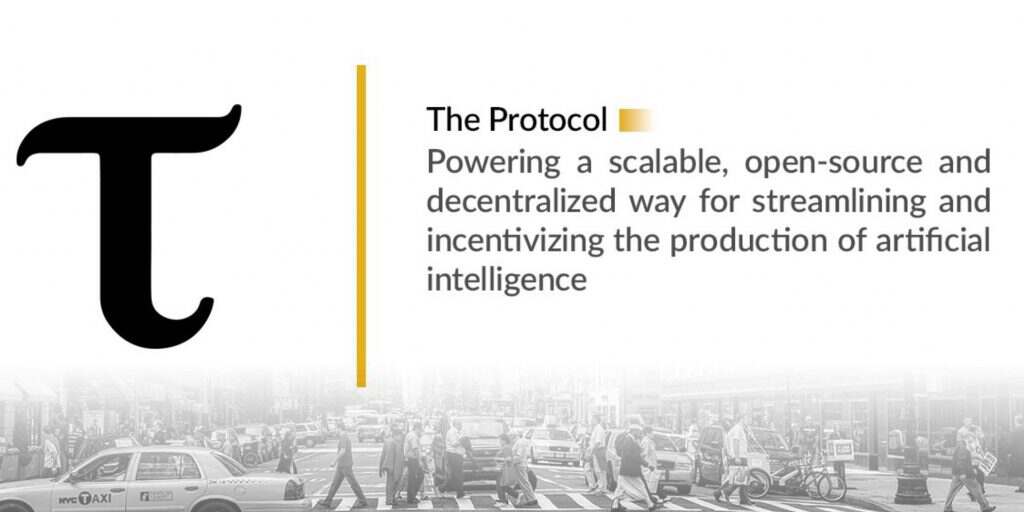
In this report, we delve into the intersection of artificial intelligence and cryptocurrency, focusing on Bittensor and the $TAO token, and discuss their roles in the rise of peer-to-peer intelligent markets and digital commodity markets.
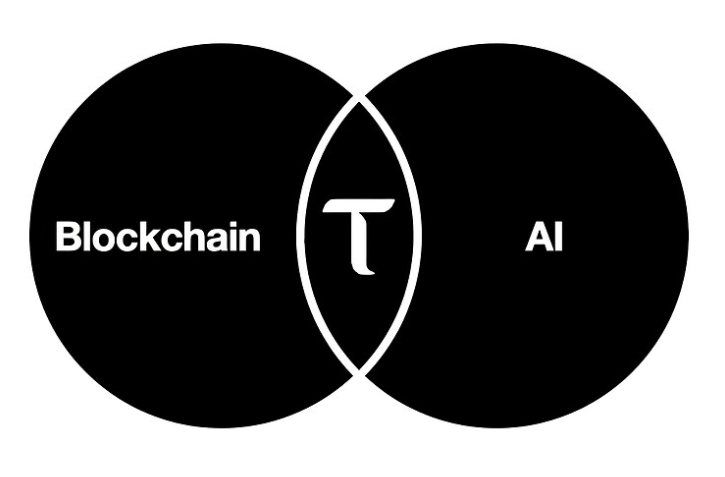
"Utilizing the recent Revolution upgrade on October 2, this article also provides a historical overview, industry outlook, competitive analysis, and an in-depth exploration of the value proposition of $TAO."
Overview
Bittensor is an open-source protocol with the core mission of driving the development of artificial intelligence through blockchain-driven incentive structures. In this ecosystem, contributors are rewarded with $TAO tokens for their efforts.
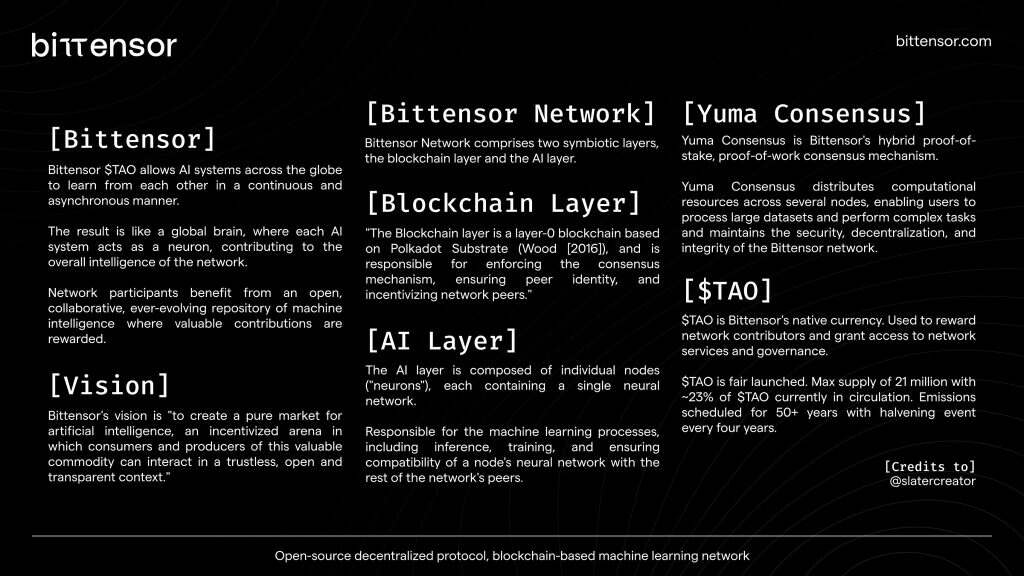
As a mining network, Bittensor uses token incentives to encourage participation while adhering to principles of openness and decentralization. In this network, multiple nodes host machine learning models, collectively contributing to the intelligence pool. These models play a crucial role in analyzing large amounts of text data, extracting semantics, and generating valuable insights across various domains. For users, basic functionalities include querying the network for intelligent access permissions, participating in $TAO token mining with miners and validators, and overseeing their wallets and balances.
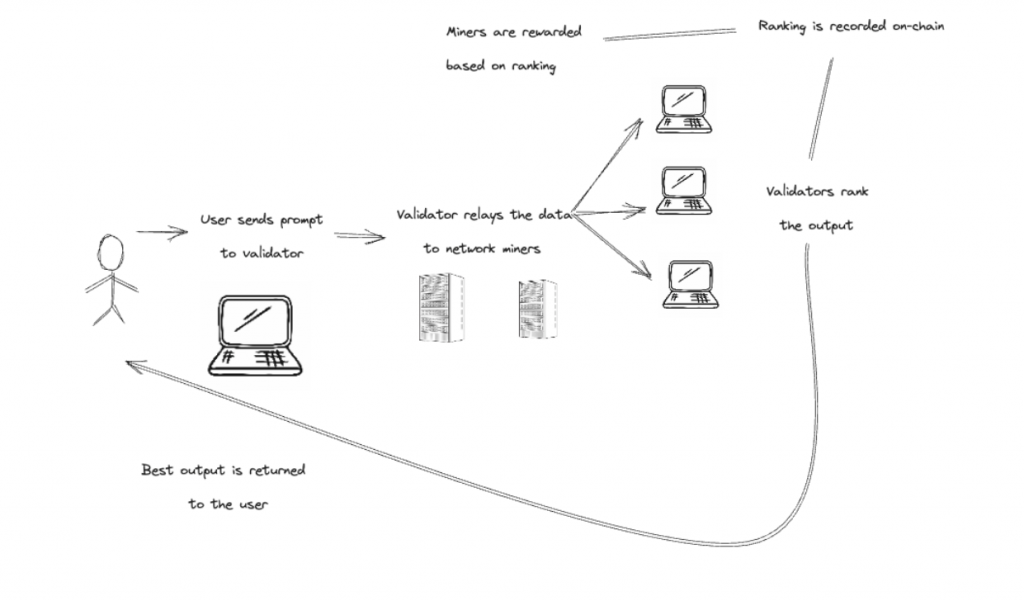
Bittensor's network relies on contributions from various stakeholders, including miners, validators, nominees, and consumers. This collaborative approach ensures the emergence of the best artificial intelligence models and enhances the quality of artificial intelligence services provided by the network.
There are two layers of suppliers: artificial intelligence (miners) and blockchain (validators).
Miners in the Bittensor network host artificial intelligence models and provide them to the network, and their success depends on the quality and performance they provide.
Miners are compensated with $TAO based on their intelligence contributions (although this depends on the specific tasks at hand).
The demand for top models can bring more income to miners.
Validators act as evaluators within the network. They assess the quality and effectiveness of artificial intelligence models and manage user requests. Through this process, validators can rank models based on performance for specific tasks, helping consumers find the best solutions. The more accurate and consistent their evaluations, the more rewards they receive. Similarly, inconsistent evaluations may lead to penalties, ensuring that validators maintain high standards.
Validators are incentivized with $TAO based on the "intelligence contributions" of miners.
Validators are also responsible for routing inputs to generate the best outputs. This is achieved by forming alliances among complementary (subnetwork) miners (models).

On the demand side, developers can build applications on top of validators, utilizing (and paying for) artificial intelligence capabilities for specific use cases from the network.
Nominees hold $TAO tokens and actively support specific validators by delegating tokens to them, which can help validators gain more support and rewards. Nominees themselves are rewarded for participating in this process. If a validator performs poorly or if nominees believe there is a better choice, they can transfer their support to another validator.
Consumers are the end users of the AI models provided by Bittensor. They may be application developers integrating artificial intelligence capabilities into their applications, or users seeking high-quality responses from chatbots.
Consumers prioritize obtaining accurate and valuable answers.
Developers choose validators they believe best fit their requirements to ensure top-notch artificial intelligence services for their users.
The coordination among the stakeholders mentioned above creates a network that promotes the best models for specific use cases. Anyone can experiment, making it difficult for closed-source enterprises to compete.
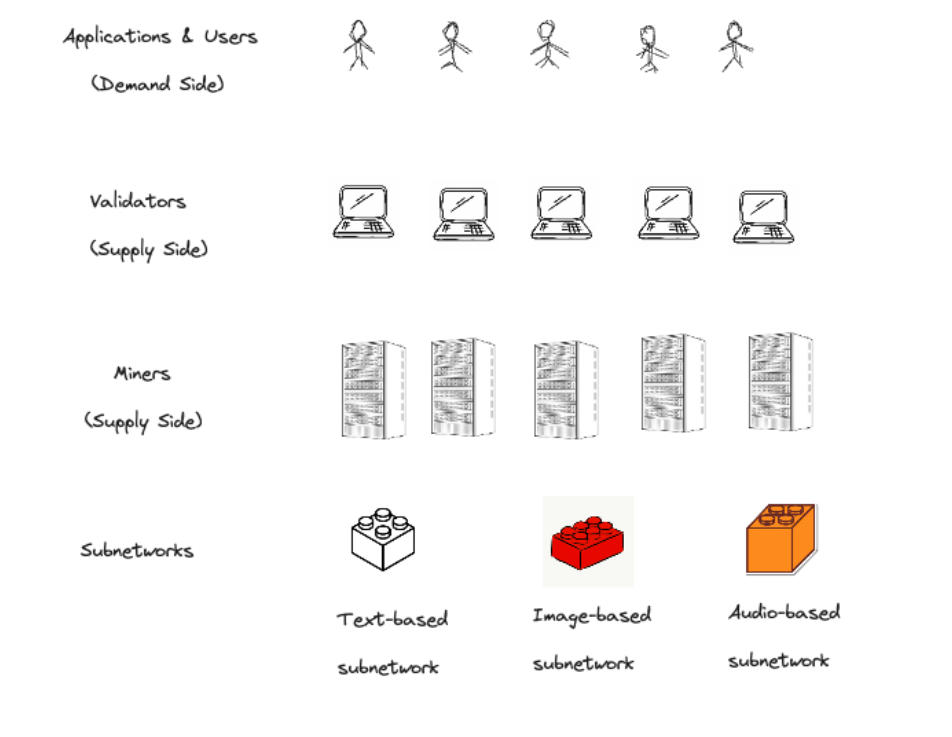
Among many misconceptions, one of the most common is the belief that the network supports the training of machine learning (ML). At its current state, Bittensor only supports inference, the process of drawing conclusions and providing responses based on evidence and reasoning. Training is a separate process that involves teaching machine learning models to perform tasks. This is achieved by providing the model with a large labeled example dataset, enabling it to learn patterns and associations between data and labels. Meanwhile, inference uses trained machine learning models to make predictions on new, unseen data. For example, a model trained to classify images can be used for inference to determine the category of new images not seen before.
Therefore, it is important to note that Bittensor does not execute on-chain ML; its functionality is more like an on-chain Oracle or a network of validators connecting and orchestrating off-chain ML nodes (miners). This configuration creates a decentralized expert ensemble (MoE) network, which is an ML architecture that integrates multiple models optimized for different capabilities to form a more powerful overall model.
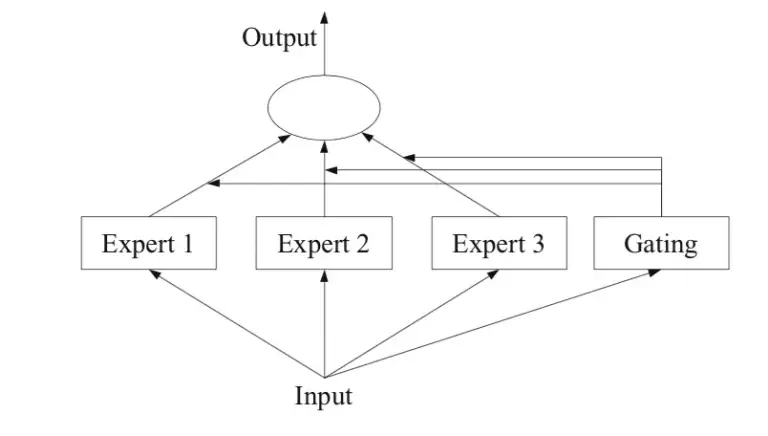
Peer-to-Peer Intelligent Markets
Bittensor's peer-to-peer intelligent market is a groundbreaking concept in the field of artificial intelligence development, providing a decentralized and permissionless platform that contrasts sharply with more closed models such as OpenAI or Google Gemini.
The market aims to promote competitive innovation, drive the development of the artificial intelligence industry, and enable global developer and user communities to utilize artificial intelligence. Any form of value can be incentivized, creating a protocol for a fair market for any digital commodity. In other words, the protocol embodies a peer-to-peer approach to exchanging machine learning capabilities and predictions among participants in the network. It facilitates the sharing and collaboration of machine learning models and services, fostering a cooperative and inclusive environment where both open-source and closed-source models can be hosted.
Rise of the Digital Commodity Market
Bittensor's uniqueness lies in laying the foundation for the emergence of the digital commodity market, effectively transforming machine intelligence into tradable assets. The core of this protocol is to establish a market for the commercialization of machine intelligence.
Similar to genetic algorithms, Bittensor's incentive system continuously evaluates the performance of miners and selects or recycles miners over time. This dynamic process ensures that the network remains efficient and can respond to the evolving landscape of artificial intelligence development.
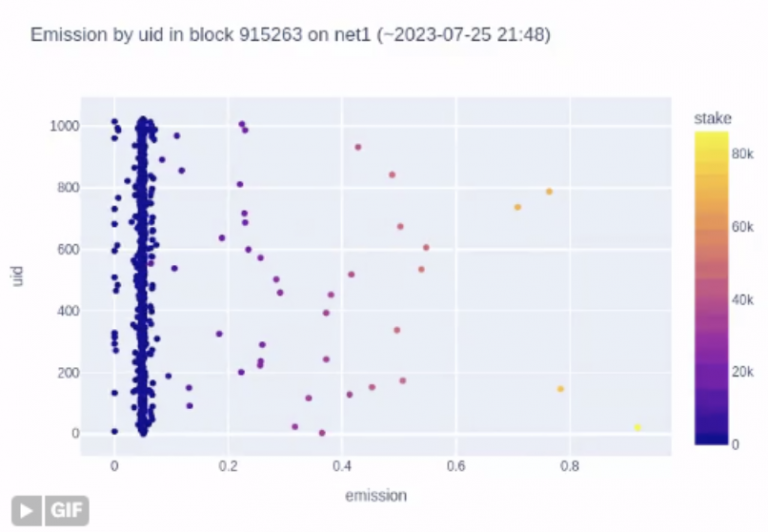
In the Bittensor intelligence market, value generation follows a dual approach:
High-performance artificial intelligence models hosted by miners (referred to as contributors) are rewarded in the form of $TAO tokens.
Validators who assess and utilize intelligence also receive $TAO token rewards.
It is worth noting that Bittensor not only rewards raw performance but also emphasizes the generation of the most valuable "signals." This means that the reward system prioritizes creating information that provides substantial benefits to a wide audience, ultimately contributing to the development of more valuable commodities.
Yuma Consensus
As an independent Layer1 blockchain, Bittensor is supported by the Yuma consensus algorithm. It is a decentralized peer-to-peer consensus algorithm designed to achieve fair distribution of computational resources within the node network.
Yuma adopts a hybrid consensus mechanism that combines elements of proof of work (PoW) and proof of stake (PoS). Nodes in the network perform computational work, validate transactions, and create new blocks. This work is also verified by other nodes, and successful contributors receive token rewards. The PoS component encourages nodes to hold tokens, aligning their interests with the stability and growth of the network.
Compared to traditional consensus mechanisms, this hybrid model offers several advantages. It avoids the excessive energy consumption typically associated with proof of work (PoW), addressing environmental concerns. Additionally, it mitigates the centralization risks associated with proof of stake (PoS), maintaining the decentralization and security of the network.
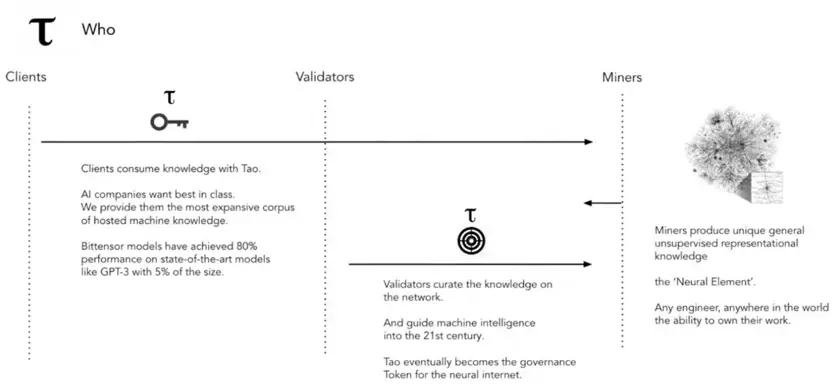
The Yuma consensus mechanism stands out for its ability to distribute computational resources across a wide network of nodes. This approach has far-reaching implications as it can easily handle more complex artificial intelligence tasks and larger datasets. As the network integrates more nodes, it naturally scales to accommodate increasingly large workloads.
Compared to traditional centralized artificial intelligence applications that rely on single servers or clusters, applications supported by Yuma can be distributed across the node network. This distribution optimizes the utilization of computational resources, enabling the handling of complex tasks while mitigating the risks associated with single points of failure and security vulnerabilities.
Knowledge Refinement - Digital Hivemind
Knowledge refinement is a fundamental concept in the Bittensor protocol, promoting collaborative learning among network nodes to enhance performance and accuracy. Similar to how neurons in the human brain work together, knowledge distillation enables nodes to collectively improve within the network over time.
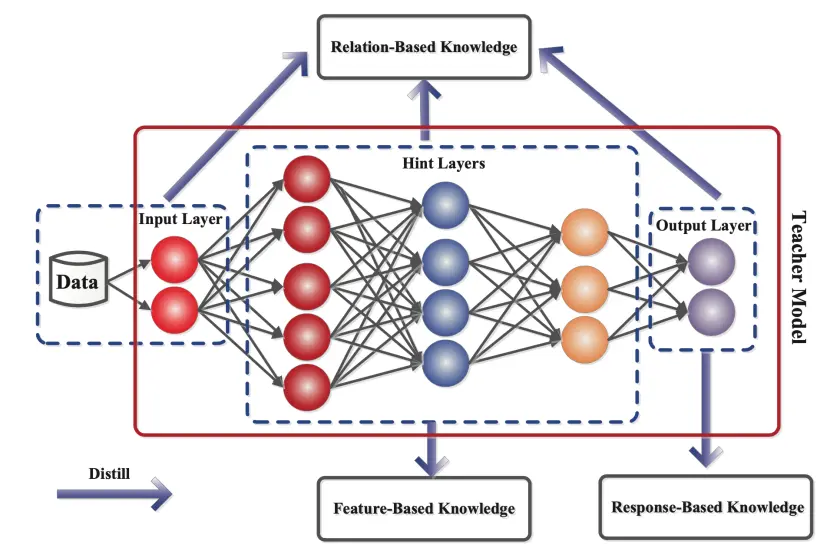
This process involves the exchange of data samples and model parameters among nodes, forming a network that self-optimizes over time to achieve more accurate predictions. Each node contributes to the shared pool, ultimately enhancing the overall performance of the network, making it faster and more suitable for real-time learning applications such as robotics and autonomous vehicles.
Crucially, this approach mitigates the risk of catastrophic forgetting, a common challenge in machine learning. Nodes retain and expand their existing knowledge while incorporating new insights, enhancing the network's resilience and adaptability.
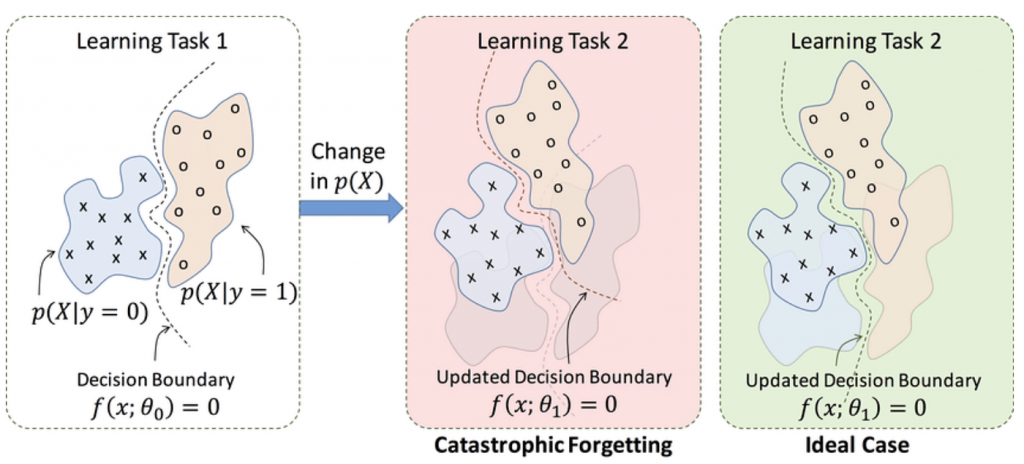
By distributing knowledge among multiple nodes, the Bittensor TAO network becomes more resilient to interference and more flexible in the face of potential data leaks. This robustness is particularly important for applications handling highly secure and privacy-sensitive data (such as financial and medical information) (privacy will be detailed later).
Mixture of Experts (MoE)
The Bittensor network further innovates by introducing the concept of decentralized Mixture of Experts (MoE). This approach harnesses the power of multiple neural networks, each specializing in different aspects of data. When new data is introduced, these experts collaborate to produce collective predictions more accurate than any individual expert could achieve alone.
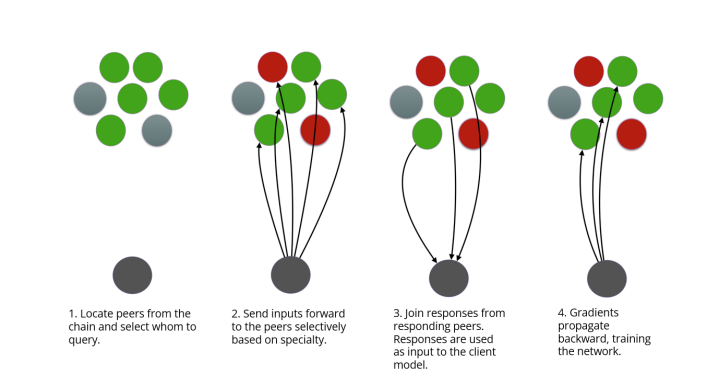
The consensus mechanism employed combines deep learning with blockchain consensus algorithms. Its primary goal is to distribute equity as an incentive for nodes that contribute the most information value to the network. Essentially, it rewards those who enhance network knowledge and capabilities.
At the core of the Bittensor protocol are parameterized functions, commonly referred to as neurons. These neurons are distributed in a peer-to-peer manner, with each neuron holding zero or multiple network weights recorded on the digital ledger. Nodes actively engage in mutual ranking, training neural networks to determine the value of their neighboring nodes. This ranking process is crucial for assessing the individual nodes' contributions to the overall performance of the network.
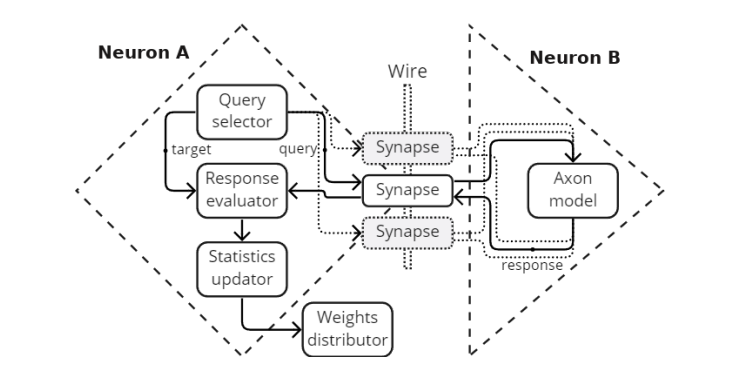
The scores generated through this ranking process accumulate on the digital ledger. Nodes with higher rankings receive currency rewards, gaining additional weight within the network. This direct link between node contributions and rewards promotes fairness and transparency within the network.
This approach provides a market where other intelligence systems price intelligence over the internet in a peer-to-peer manner. It incentivizes nodes to continually enhance their knowledge and expertise.
To ensure fair distribution of rewards, Bittensor adopts the Shapley value, a concept borrowed from cooperative game theory. The Shapley value provides a fair and efficient method to allocate rewards among network nodes based on their contributions. This incentive, combined with contributions, encourages nodes to act in the best interest of the network, enhancing security and efficiency while driving continuous improvement.
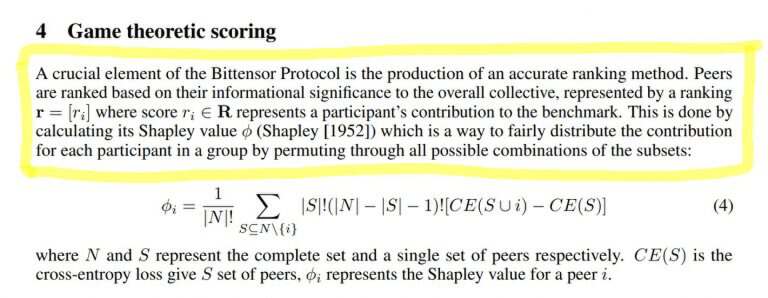
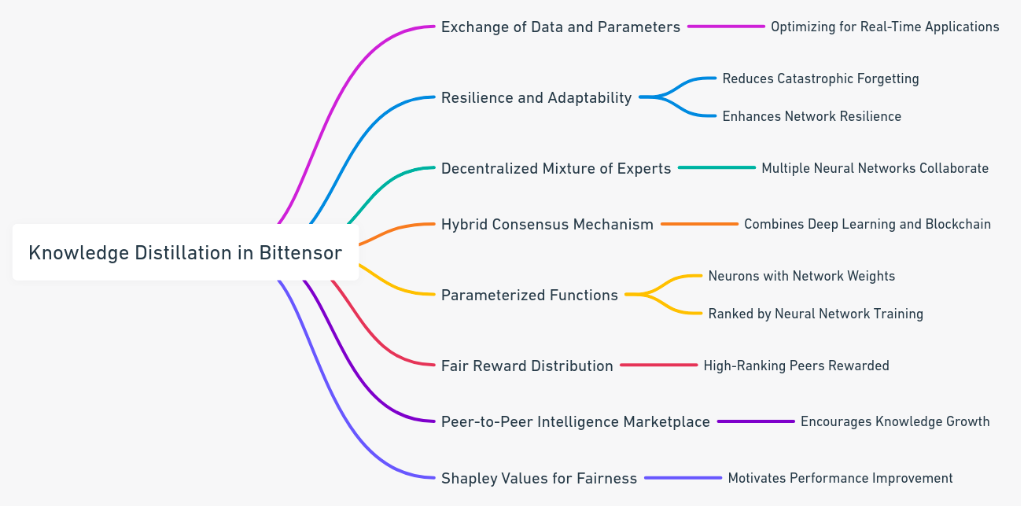
Bittensor's core mission is to promote innovation and collaboration in the field of artificial intelligence through a decentralized framework. This framework enables rapid expansion and sharing of knowledge, creating a continuously growing and unstoppable repository of information. In this market, developers have the right to monetize their artificial intelligence models and provide valuable solutions to businesses and individuals.
Bittensor's vision extends into the future, where artificial intelligence models can be easily accessed and deployed across various industries. This accessibility drives progress and unlocks new possibilities, bridging the gap between artificial intelligence capabilities and real-world applications.
Similar to well-known global AI models like Chat GPT, Bittensor models generate "representations" based on general datasets. To evaluate the performance of the models, Fisher's information is used to assess the impact of removing a node from the network, similar to losing a neuron in the human brain.
In addition to model ranking, Bittensor places great emphasis on interactive learning. Each model actively interacts with the network, seeking interactions with other models, similar to DNS lookups. Bittensor acts as an API, facilitating data exchange between these models, both open-source and closed-source, promoting collaborative learning and knowledge sharing.
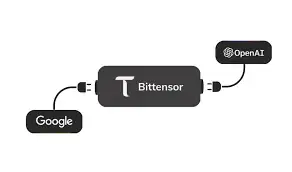
The ecosystem leverages Yuma consensus to ensure compliance with rules, driving open-source developers and AI research labs to enhance open-source base models with economic incentives.
Essentially, Bittensor's role is that of an ever-expanding repository of machine intelligence. This is achieved by integrating four different layers:
- Miner Layer: Responsible for generating valuable work in the network.
- Validator Layer: Ensures miners adhere to established consensus rules.
- Enterprise Layer: Built on existing infrastructure, developing innovative products and services. It is a platform for creating new solutions using collective intelligence within the network.
- Consumer Layer: Benefits from the work generated by the Enterprise Layer. Represents end users or organizations using products and services powered by the Bittensor network.

Bittensor's Development History
Bittensor was founded in 2019 by two AI researchers, Jacob Steeves and Ala Shaabana, along with an anonymous whitepaper author, Yuma Rao. They were looking for a way to make AI composable. They quickly realized that cryptocurrency might be the solution—a way to incentivize and coordinate a global machine learning node network to collectively train and learn specific problems. The incremental resources added to the network raised overall intelligence, compounding the work of previous research and models.
Bittensor's journey began with the "Kusanagi" release in January 2021, marking the network's activation, allowing miners and validators to start earning the initial batch of $TAO rewards. However, this initial version was paused due to consensus issues. In response, Bittensor forked "Kusanagi" into "Nakamoto" in November 2021.
On March 20, 2023, Bittensor reached a significant milestone as "Nakamoto" was forked again, evolving into "Finney." The purpose of this upgrade was to improve the performance of the core code.
It is worth noting that Bittensor was initially intended to be a parachain on Polkadot and successfully secured a parachain slot in the January 2021 auction. However, due to concerns about the development speed of Polkadot, it was later decided to use its own independent L1 blockchain built on Substrate instead of relying on Polkadot.
Current Status
Bittensor has been running on the mainnet for over a year, focusing on pioneering research and laying the groundwork for future potential. Here is an overview of the current status and the reasons for not yet building business use cases on its validators:
Sparse Mixture Model: Bittensor operates as a model for the sparse mixture model. It attracts specific AI models into this mixture, with each model serving a specific role in solving larger problems defined by validators. Configuring and tuning this model to achieve state-of-the-art levels is a complex and iterative process. Currently, this phase of the roadmap is led by Opentensor Foundation.
Intelligent Compression (Distillation): Intelligent compression is a core research focus for Bittensor, involving distillation techniques to improve network efficiency and capabilities.
Optimization for Grand Goals: Bittensor's primary focus is on optimizing for grand goals rather than short-term business use cases. Opentensor is committed to creating a network beyond a simple peer-to-peer platform with a model pricing system.
Progress and Updates: Over the past year, Opentensor has made significant progress, including the Synapse update, which opened Bittensor to external requests. In October 2023, the Revolution upgrade achieved expansion through subnets, allowing large validators to independently define problems, creating opportunities for cash flow in their stakes.
Expansion into Real-World Use Cases: The Finney network marks a turning point for Bittensor, allowing validators to act more independently and reducing initial centralization. The growth of network stakes and block rewards is driving the growth of artificial intelligence.
Upcoming AI Business Use Cases: Bittensor envisions the expansion of real-world AI business use cases as stakeholders, including humans and AI, follow their incentives. The implementation of multimodal and meta-modal is forthcoming, merging subnets into a unified "intelligent" format.
With the latest Revolution upgrade, Bittensor enables anyone to create subnets tailored for specific types of applications. For example, Subnet 4 uses JEPA (Joint Embedding Predicted Architecture), an AI approach pioneered by Meta's Yann LeCun for handling various input and output types such as video, images, and audio.
Another notable achievement is Cerebras' BTLM-3B-8K (Bittensor Language Model), a 3B parameter model that enables highly accurate and high-performance models to run on mobile devices, making AI more accessible. BTLM-3B-8K is available on Hugging Face and is licensed for commercial use under Apache 2.0.
Large GPT models typically have over 100 billion parameters and require multiple high-end GPUs for inference. However, the release of LLaMA from Meta enables the world to obtain high-performance models with only 7 billion parameters, allowing LLMs to run on high-end PCs.
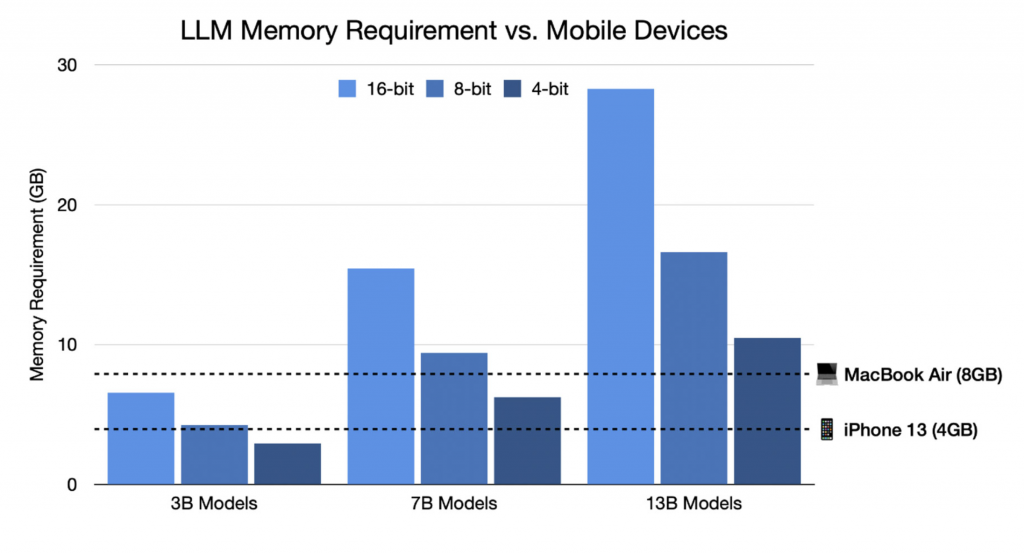
Even when quantizing a model with 7 billion parameters to 4-bit precision, it still cannot fit on many popular devices such as the iPhone 13 (4GB RAM). A model with 3 billion parameters, on the other hand, can easily fit on almost all mobile devices, but the performance of the previous 3 billion parameter models was far inferior to their 7 billion parameter counterparts. BTLM strikes a balance between model size and performance. It has 3 billion parameters and offers a level of accuracy and capability significantly superior to previous models of the same size.
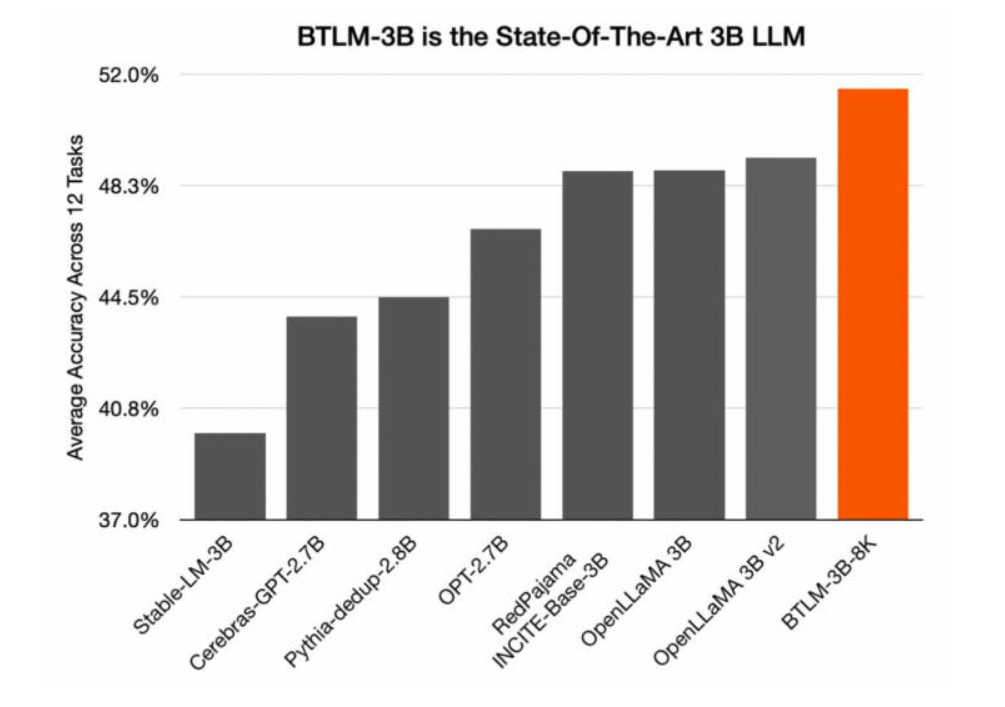
When looking at various benchmarks, BTLM scores highest in every category except for TruthfulQA.
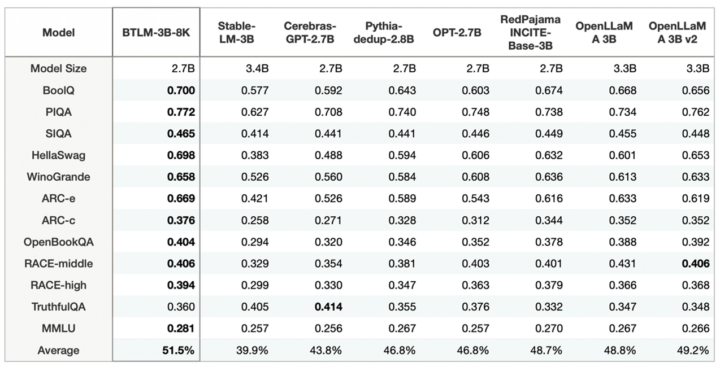
BTLM-3B not only outperforms all 3 billion parameter models but also competes in performance with many 7 billion parameter models.
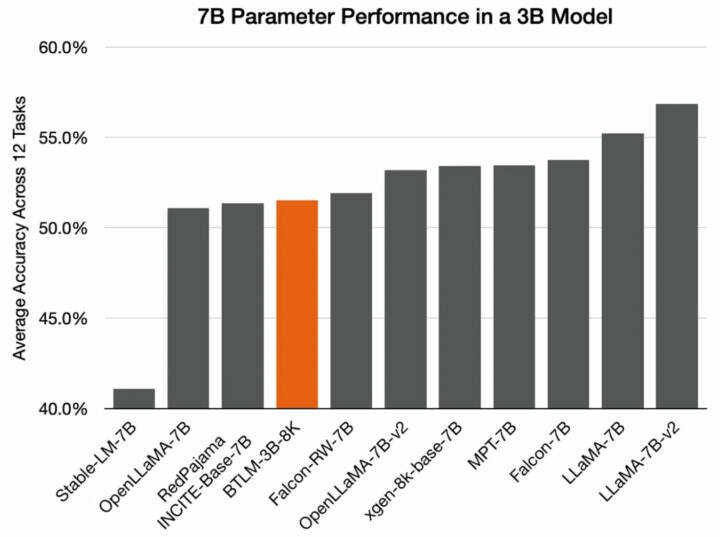
Revolution – Bittensor Subnet Upgrade
Bittensor's Revolution upgrade, launched on October 2nd, marks a significant milestone in the development of Bittensor, bringing about significant changes to its operational structure. The core of this upgrade is the introduction of "subnets," a groundbreaking concept that provides unprecedented autonomy for developers to shape their incentive mechanisms and establish markets within the Bittensor ecosystem.
A key feature of this upgrade is the introduction of a dedicated programming language designed for creating incentive systems. This innovation enables developers to create and implement their incentive mechanisms on the Bittensor network, leveraging its vast intelligence pool to customize markets to meet their specific requirements and preferences.
This upgrade also represents a significant departure from centralized models, where a single foundation controls all aspects of the network, towards a more decentralized framework. Now, various individuals or groups have the opportunity to own and manage subnets.
With the introduction of "subnets," anyone can now create their own subnetworks and define their incentive mechanisms, promoting a wider range of services within the Bittensor ecosystem. This shift promotes diversity and decentralization within the network, aligning with Bittensor's principles of openness and collaboration.
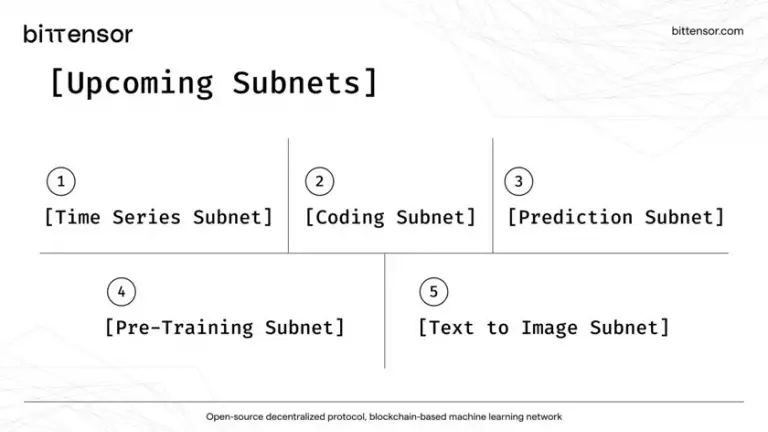
Furthermore, subnets will compete for issuance by obtaining weighted consensus represented in the new "routing network," introducing a competitive element that can drive innovation and resource allocation.
The emergence of user-created subnets may evoke the explosive growth of applications after Ethereum opened its doors to the global developer community. This upgrade also emphasizes the potential to consolidate various tools and services into a cohesive network. Essentially, every element required to build intelligence is now centralized under one roof and governed by a single token ($TAO).
Routing Network
The routing network plays a crucial role in the Bittensor ecosystem. It acts as a meta-subnet, distributing issuances between other subnets based on the weighted consensus of primary representatives. This transformation is profound as it fundamentally shifts Bittensor from a singly controlled system to a dynamic "network of networks."
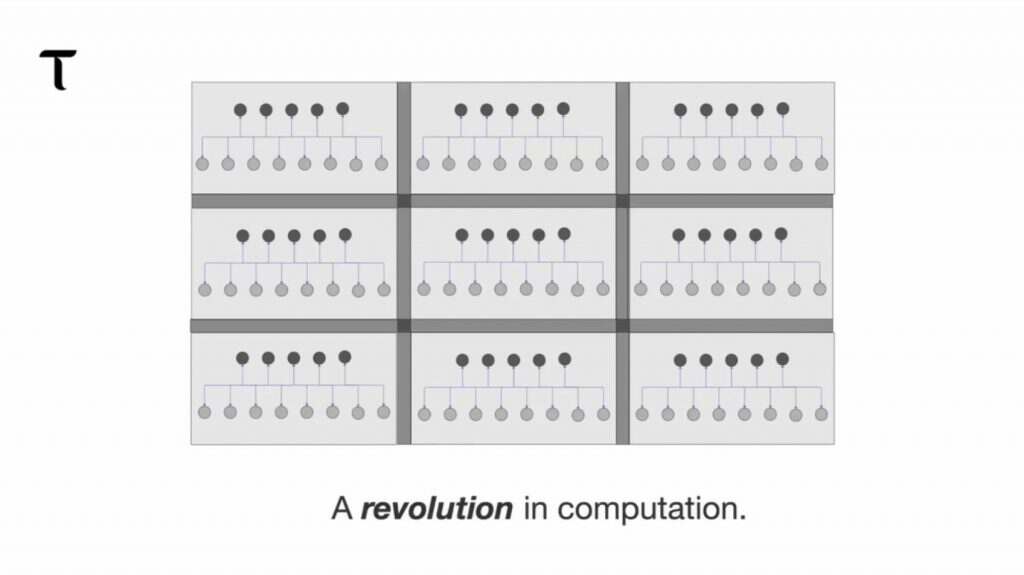
Crucially, the issuance schedule is no longer entirely under the control of the Opentensor Foundation. Representatives within the "root" network now have authority over incentive allocation. This shift decentralizes control over incentives, no longer relying entirely on any single entity and placing it under the control of the "root" network.
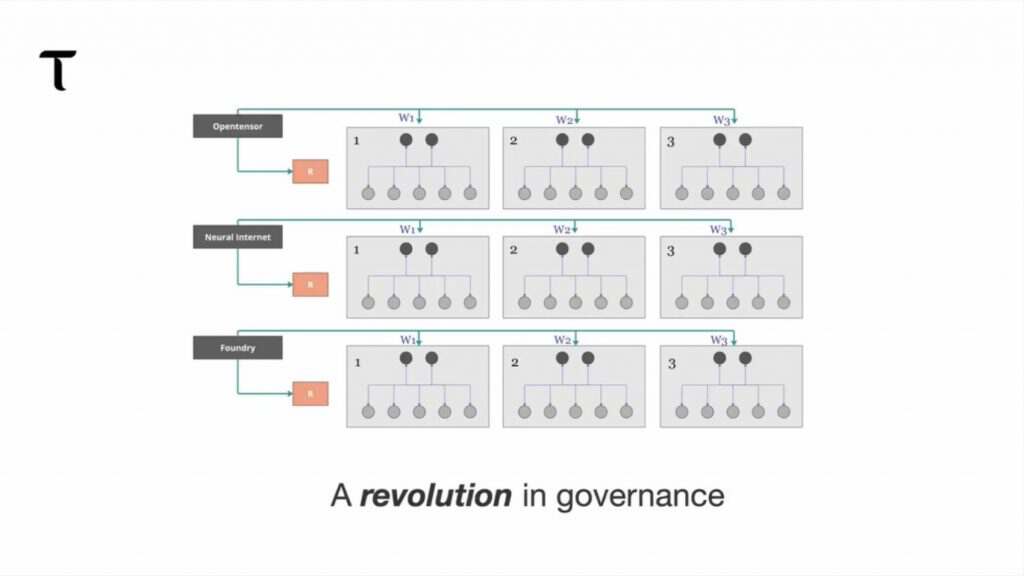
Subnets
Subnets within the Bittensor network are independent incentive mechanisms that provide a framework for miners to interact with the platform. These subnets play a crucial role in defining the protocols for managing interactions between miners and validators.
Additionally, the details of incentive mechanisms are no longer hardcoded in the Bittensor codebase. Instead, these details are defined in subnet repositories, providing greater flexibility and adaptability.
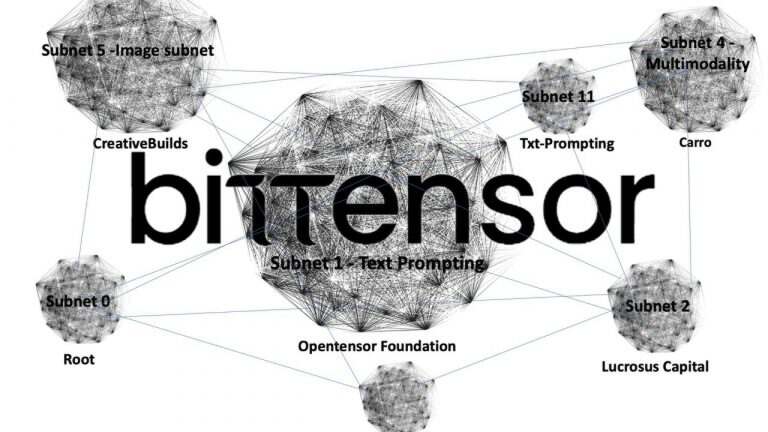
Bittensor introduces specific subnetworks, such as Prompt Subnet and Time Series Subnet. The Prompt Subnet is capable of executing various prompt-based neural networks, including GPT-3, GPT-4, ChatGPT, etc., for decentralized inference. This feature allows users to interact with validators on the network and obtain outputs from the best-performing models, providing advanced AI capabilities for their applications.
The operation of subnets is based on the value that miners and validators contribute to the network, with $TAO tokens allocated to them. The specific rules and protocols for miners' responses to validator queries and the evaluation process by validators are determined by the code within each subnet repository.
At launch, 9 subnet slots will be provided, each slot capable of accommodating 256 UIDs by default (except for Subnet 1, which can accommodate 1024 UIDs). Subnets will actively compete for issuance by seeking weighted consensus within the "root" network.
To register a subnet, individuals or entities must lock a specific amount of $TAO for the duration of the subnet's existence. Subnet owners take on the role of full network administrators and have the authority to allocate emissions through their respective subnets. They have full permissions, including the ability to perform sudo operations through network calls, such as setting the network's minimum fee rate, etc.
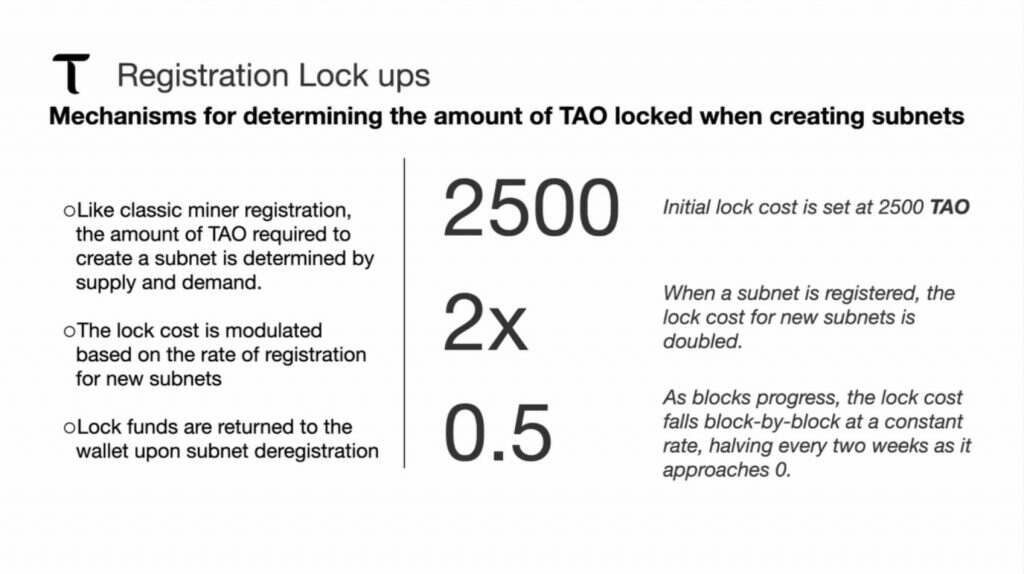
Each subnet is associated with a unique network UID, and ownership of the subnet will transfer to the wallet that locked the required amount of $TAO for its registration. When a subnet is created, the corresponding amount of $TAO will be deducted from the creator's wallet and attached to the subnet. If the subnet is deregistered, the locked $TAO will be returned to the owner.
It is worth noting that 18% of the $TAO staked in the subnet will be returned to the subnet owner. This will incentivize subnet creators to devise mechanisms that attract representatives on the routing network, as it increases their chance of avoiding deregistration.
Newly registered subnets have a grace period of one week during which they cannot be deregistered. The initial locking cost is 2500 $TAO, which doubles upon registration of a new subnet. Over time, the locking cost gradually decreases in a linear fashion, following a mechanism similar to a Dutch auction. This approach aims to find a balance in subnet slot demand by adjusting the locking cost over time.
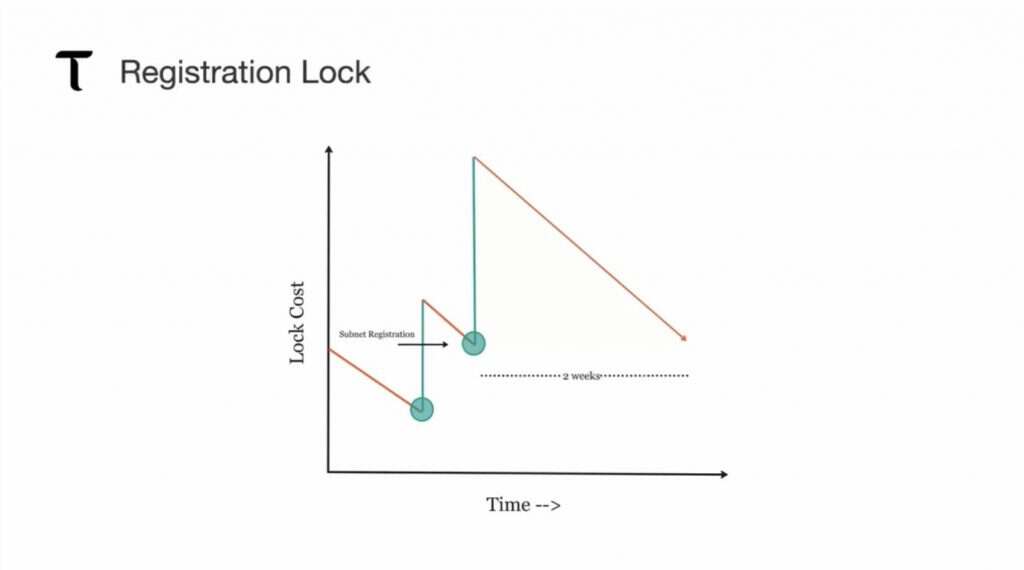
- When a subnet is deregistered, the $TAO used for its registration will be returned to the owner, and all miners within the subnet will be removed, resetting the network state.
Root Network
The root network acts as a "meta-subnet," positioned above other subnets and influencing their operations, while playing a crucial role in determining the issuance scores for the entire system.
Its primary function is to generate an issuance vector for each subnet based on a weighted consensus mechanism in which representatives participate. Representatives within the root network allocate weights to different subnets based on their preferences, and the final consensus mechanism determines the allocation of issuances.
An important aspect is that the "root" network effectively consolidates the roles of the senate and representative mechanisms, integrating these functions into a single entity. This integration streamlines the decision-making process within the Bittensor ecosystem.
The "root" network holds the power to shape the ecosystem by influencing incentive allocation. If it deems a specific aspect of a subnet or system to be of no value, it has the ability to reduce or eliminate incentive allocation for that component.
Subnets within the Bittensor network must actively strive to attract the majority of the weight of representatives within the "root" network to ensure a significant share of released incentives. This competitive aspect emphasizes the importance of subnets showcasing their value and utility to the broader ecosystem.
Additionally, it empowers the top 12 keys within the network to veto proposals submitted by the triad, adding an additional governance layer and checks and balances to the system.
Industry Outlook
In the tech industry, power has long been concentrated in the hands of a few tech giants. These giants have maintained control over valuable digital commodities crucial for driving innovation. However, Bittensor's market introduces a more democratic and accessible system, acknowledging and challenging this prevalent pattern.
The fundamental insight of Bittensor is that intelligence is the result of various digital commodities, such as computing power and data. Historically, these commodities have been tightly controlled, restricted to the domains of tech giants. Bittensor seeks to break free from these constraints by introducing user-created subnets. These markets will operate under a unified token system, ensuring equal access to resources that were once exclusive to a few elite entities within closed tech ecosystems for global developers.
Potential Adoption
The transformative power of artificial intelligence (AI) in today's digital age is undeniable. AI has become an indispensable part of our lives, simplifying research, automating workflows, assisting in coding, and generating content from text. The rapid growth of AI capabilities is evident, but this growth also brings challenges related to scalability and, most importantly, reliability. Recent events, such as the temporary interruptions experienced by ChatGPT during discussions on AI regulation in Washington, highlight the urgent need for robust solutions to address the challenges of AI expansion. These interruptions have raised concerns about the stability and reliability of AI as it becomes increasingly integrated into everyday life. It is in these moments that the importance of $TAO from Bittensor becomes evident.
Bittensor's approach not only supports open-source AI but also demonstrates that it can be a financially rewarding pursuit. It draws from the competitive evolution seen in Bitcoin mining and paves the way for a thriving market where the best AI models rise to the top. This transformation empowers AI researchers to contribute their expertise in an open and dynamic environment, ultimately benefiting society as a whole.
$TAO provides a decentralized infrastructure for artificial intelligence, which can mitigate potential issues encountered by ChatGPT. Through decentralized AI, Bittensor ensures the resilience and reliability of AI systems, even as their demand continues to grow. This approach lays a solid foundation for the future of AI services.
In summary, Bittensor is a global open-source AI market that offers a compelling solution to the challenges faced by closed-source AI development.
Excellence in AI: Bittensor acts as a gravitational force, attracting the best AI models from researchers worldwide. By fostering a free market for AI, the network encourages the submission of cutting-edge models. As it matures, Bittensor promises to lower costs, eliminate platform risks, and provide the best AI outputs, whether in text, images, videos, or other formats.
Profitable Open Source: Bittensor transforms open-source AI into a profitable venture. Emulating the example of Bitcoin, the construction of Bittensor assumes that stakeholders are profit-driven. In this ecosystem, the best AI models earn the most money. It parallels the development of Bitcoin mining, transforming into a competitive and specialized industry. Doctoral researchers now have the opportunity to bring their research to this open market, bridging the gap between academia and the private sector.
Impressive Scale: Bittensor's incentives yield significant results. The network serves over 4,000 AI models, including an astonishing 100 trillion model parameters. This is a stark contrast to GPT-3's 175 billion parameters.
Diversified Stakeholders: Bittensor's ecosystem involves a range of stakeholders, including miners, validators, nominators, and consumers. This diversity of participation ensures the robustness and continued growth of the network.
The current state of AI is an important consideration, where much of the content remains locked within the control of closed tech companies. This raises a question: What if AI could be open and able to learn from other AI models in a collaborative environment? Bittensor's $TAO seeks to provide a solution to this question.
Adoption Driven by Growth: While some major AI companies may hesitate to open up their proprietary AI technologies, $TAO presents an intriguing proposition. It introduces the possibility of further monetizing through microtransactions. Imagine every time someone uses their trained model in the Bittensor ecosystem to build their products and businesses, mature AI solutions like OpenAI receive small payments. This could open up new revenue streams for these companies, encouraging their participation in an open AI network.
Demand-Driven Adoption: Assuming that current AI solutions remain closed and resistant to open networks, open-source has the potential to surpass these well-funded solutions. While financial resources are crucial for technological development, the potential of technologies that can learn autonomously and from the environment should not be underestimated.
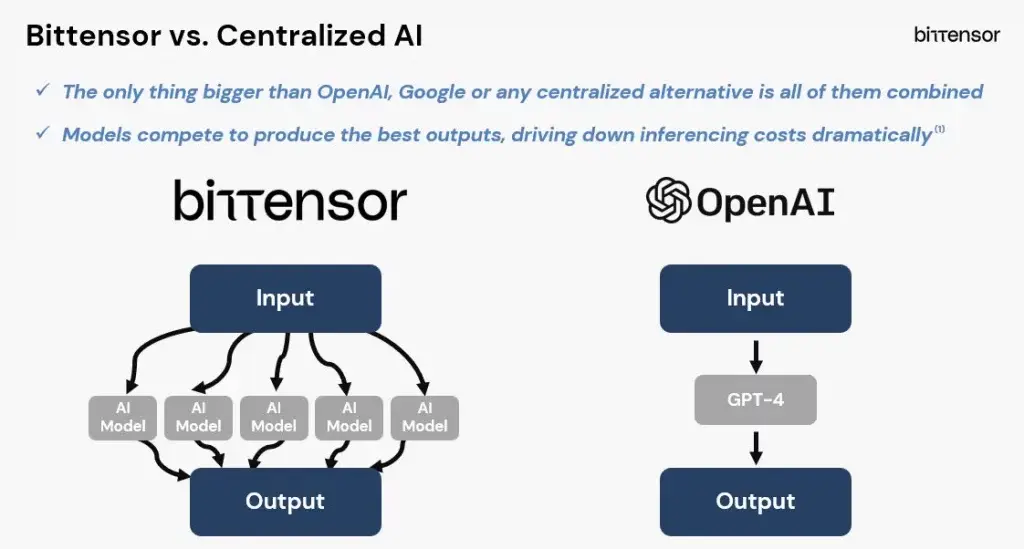
Open Source Dilemma
As concerns about alignment issues in AI continue to grow, the debate over whether AI models should be open source is gaining increasing attention. The fundamental question is whether the actual code behind AI models should be freely accessible to everyone. Interestingly, even if major players like OpenAI open source their models, this may not necessarily pose a threat to Bittensor. In an open-source environment, anyone can leverage these models on the Bittensor network.
In the tech community, there are differing opinions on this issue. Some believe that open-sourcing AI technology may empower malicious actors to use AI for harmful purposes. Conversely, others argue that granting exclusive rights to AI technology to major companies may pose greater risks. For example, centralizing AI power in the hands of a few trillion-dollar companies, as evidenced by OpenAI's focus on raising substantial funds, could raise ethical concerns and highlight the risk of power corruption.
Meta's decision to open-source its Llama2 LLM indicates an industry shift towards embracing open-source practices. This move provides Bittensor with the opportunity to learn and potentially integrate Meta's advancements into its network, narrowing the performance gap more rapidly.
It is essential to examine the valuation of $TAO and OpenAI. Currently, OpenAI holds a dominant position in the industry, with a valuation between $80 billion and $90 billion. However, it operates within a closed ecosystem heavily reliant on Microsoft and its controlled cloud services. Nevertheless, OpenAI has successfully attracted top talent from around the world. On the other hand, as time progresses and open-source initiatives become more widespread, the scope of available talent is expected to exponentially expand, covering every corner of the internet. This democratization of AI expertise may play a crucial role in shaping the adoption of Bittensor.
Competitive Landscape - Centralized AI
Developer adoption remains a key factor in Bittensor's development path. Currently, developers can interact with the network through the Python API developed by the OpenTensor Foundation, highlighting the importance of nurturing a strong developer community to drive adoption. Bittensor is actively working to decentralize key aspects of the network, such as model creation and training, rewarding the most finely-tuned models, while promoting community-driven decision-making.
Interestingly, established players in the AI space, including OpenAI and Google, have now become competitors to $TAO. They are deeply involved in the generation of AI models and even venture into potential vertical integration within various industries. In this context, one of the major challenges faced by $TAO is the issue of data partitioning.
Unlike tech giants like Facebook, Apple, Amazon, Netflix, and Google (FAANG), which have access to vast meaningful data repositories, crowdsourced communities may lack the same level of resources and data access. FAANG organizations have financial backing and can leverage powerful hardware, such as Nvidia's cutting-edge technologies including H100 and GH200, which can significantly accelerate AI model training.
At the same time, it is worth noting that today, all mainstream AI solutions exist in a closed and centralized form. This includes well-known companies like OpenAI, Google, and Midjourney, each offering disruptive AI solutions. However, the gap between closed and open-source models is rapidly narrowing. Open-source models are increasingly favored for their speed, customization, privacy, and overall capabilities. Compared to their closed counterparts, they achieve impressive functionality with relatively smaller budgets and parameter scales. Additionally, these open-source models operate on accelerated timelines, delivering results in weeks rather than months.
As a powerful tech giant, Google has recognized this transformative trend. An internal leaked document from the company states, "We have no moat, nor does OpenAI." This underscores the growing influence of open-source artificial intelligence in the competitive landscape.
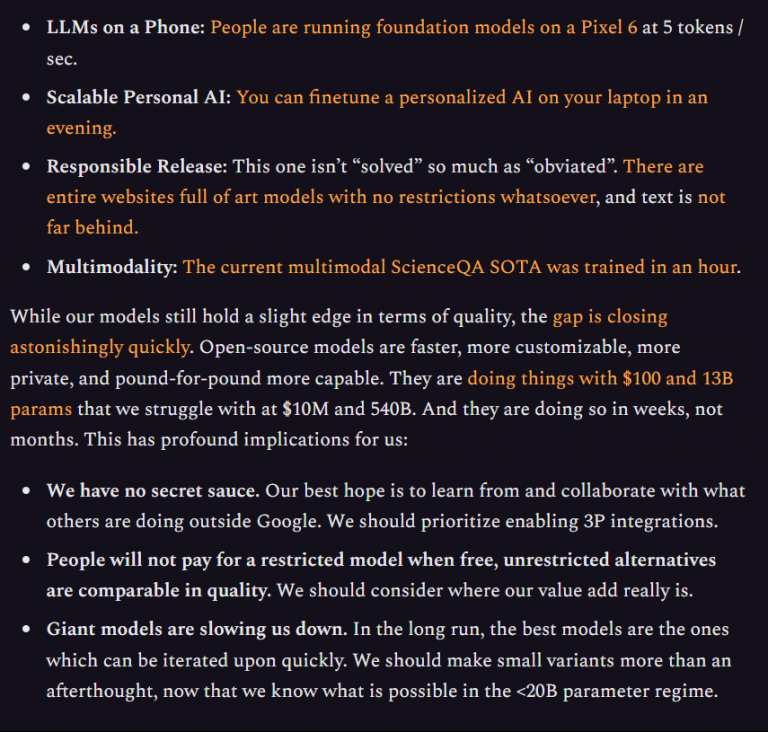
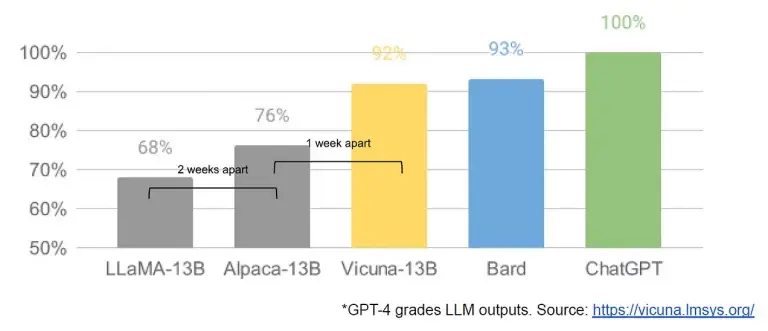
In this evolving AI ecosystem, $TAO emerges as a catalyst for change, challenging the traditional modes of AI development and training. Its decentralized approach and community-driven spirit position it as a competitor on the dynamic stage once dominated by tech giants.
Unlike centralized platforms that restrict access to individual AI models, Bittensor's architecture provides permissionless access to intelligence. It is a one-stop shop for AI developers, offering all necessary computational resources while accepting external contributions. This inclusive model interconnects the neural networks of the entire internet, creating a global, distributed, incentive-driven machine learning system.
To realize the full potential of AI, it is imperative to break free from closed-source development practices and their associated limitations. Just as children broaden their understanding through social interaction, AI thrives in dynamic environments. Exposure to diverse datasets, insights from innovative researchers, and interaction with various models contribute to the creation of more robust and intelligent AI systems. The trajectory of AI should not be determined by a single entity.
In these two starkly contrasting futures, the choice between a world dominated by black-box algorithms and centralized authority, or an open, democratized landscape of artificial intelligence, is crucial for society.
In the first scenario, where large companies like OpenAI or Anthropic control AI solutions, we face the risk of living in a constant surveillance regime. These companies would wield immense power over our personal data and daily interactions, with the authority to shut down services and report individuals with dissenting views or engaging in discussions.
However, the more optimistic choice offers a world of artificial intelligence based on open-source platforms, built on universally owned networks. Here, power and control are decentralized, and AI is an empowering tool rather than a means of surveillance. In this scenario, creativity and development can flourish without the fear of corporate biases or censorship.
Just as the internet democratized access to information, an open AI ecosystem will democratize access to intelligence. It ensures that intelligence is not monopolized by a few, fostering a fair arena where anyone can contribute, learn, and benefit.
$TAO Tokenomics
Similar to Bitcoin, the total maximum supply of $TAO tokens is limited to 21,000,000, to be fully issued over 256 years.
Halving of $TAO occurs approximately every 10.5 million blocks and will happen 64 times over the next 45 years.
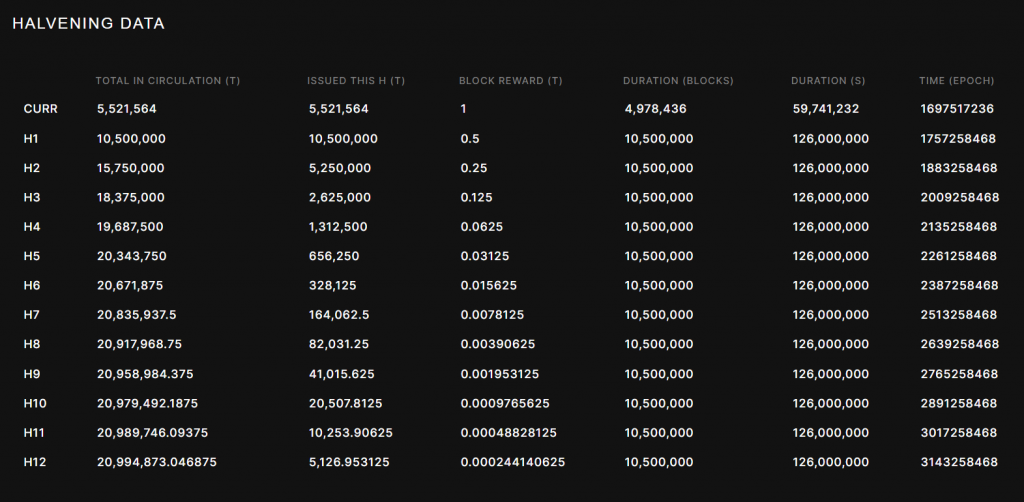
The network's block time is approximately 12 seconds, with a block reward of 1 $TAO for miners and validators.
Currently, this equates to the issuance of 7,200 new $TAO tokens per day, distributed evenly to miners and validators.
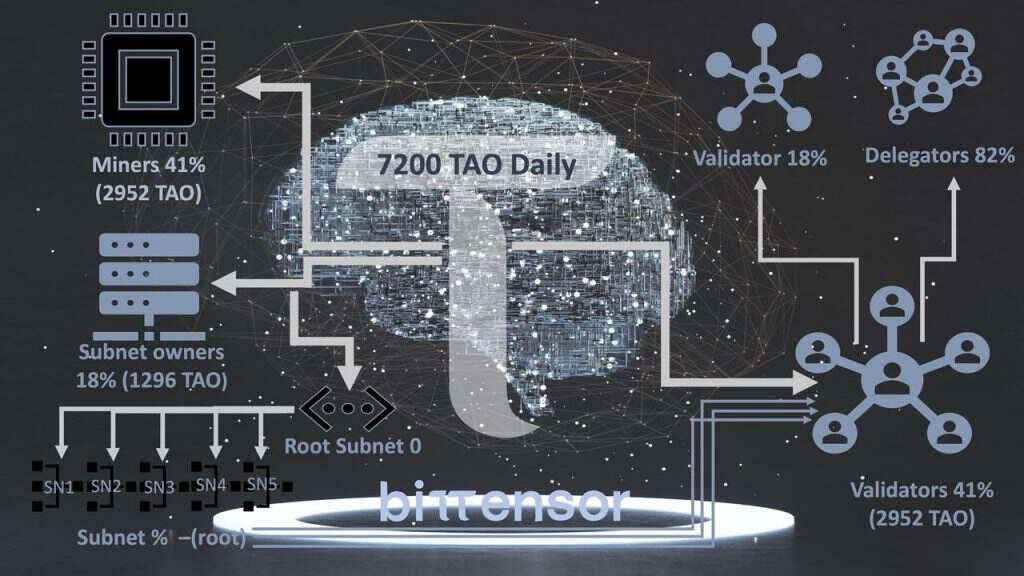
Similar to Bitcoin, the issuance schedule of $TAO also follows the concept of halving, occurring approximately every 4 years. However, this is determined by the total token supply, rather than the number of blocks. For example, once half of the total supply has been issued, the issuance rate will halve.
Importantly, the $TAO tokens used for subnet registration are burned back into the unissued supply, resulting in a gradual lengthening of the halving intervals. This mechanism ensures that the issuance schedule dynamically adjusts over time, reflecting the network's demand and economic dynamics.
$TAO Token Economy
The characteristics of Bittensor's $TAO token economy are simple, focused on decentralization, and fair distribution. Unlike many other blockchain projects, $TAO tokens have not been distributed to any party through ICOs, IDOs, private sales to VCs, or privileged allocations to teams, foundations, or advisors. Instead, every circulating token must be earned through active participation in the network.
There are capital allocators in the network who participate as miners or validators and provide liquidity services, such as DCG, GSR, or Polychain. Importantly, none of them received token allocations through presales or private sales.
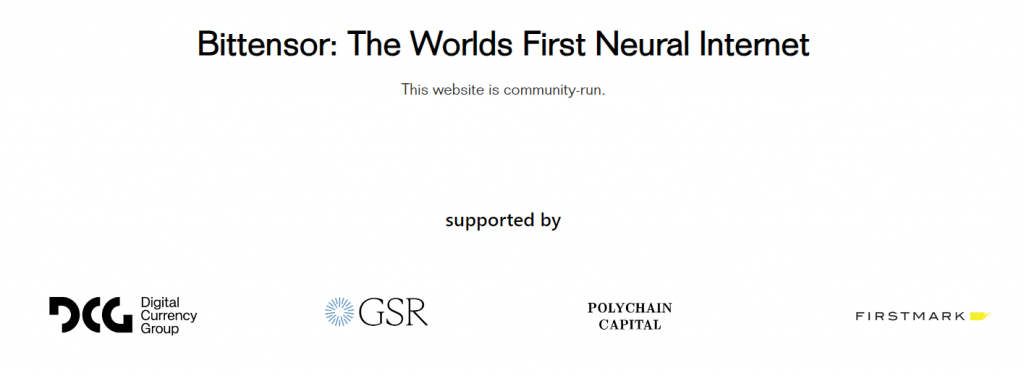
The $TAO token can be used for governance, staking, participation in the consensus mechanism, and as a means of payment within the Bittensor network.
In this way, validators and miners stake their tokens to secure the network and receive inflationary issuance rewards, while users and businesses can use $TAO to access AI services and applications built on the network.

New $TAO tokens can only be generated through mining and validation. The network rewards miners and validators, granting 1 $TAO per block, distributed evenly between miners and validators. Therefore, the only way to acquire $TAO is to purchase tokens on the open market or participate in mining and validation activities.
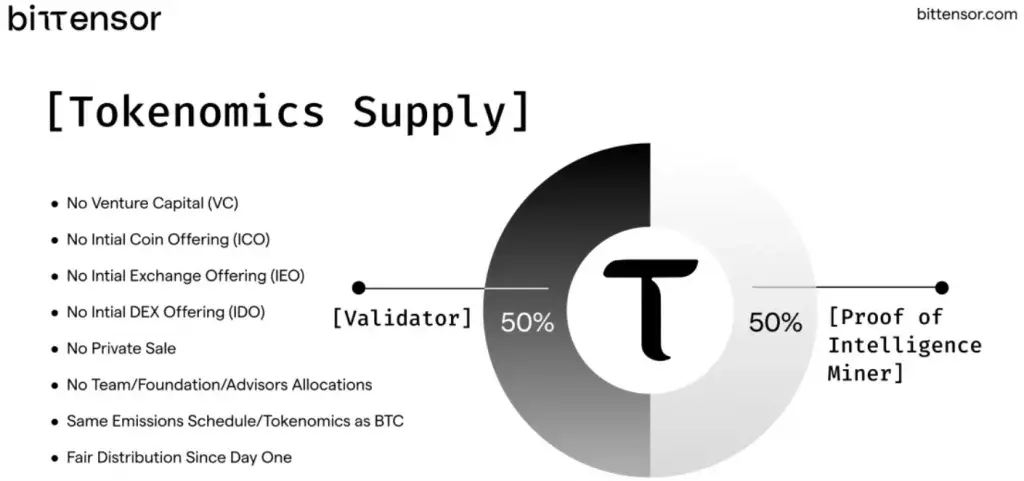
The simple token distribution model of $TAO reflects the decentralized principle, reminiscent of the spirit set by Satoshi Nakamoto for Bitcoin. The genesis minting of $TAO aligns with the release schedule of Bitcoin ($BTC), providing equal opportunities for anyone contributing value to the network. This approach emphasizes the importance of preventing power and ownership concentration, especially in the field of artificial intelligence, which has significant societal implications and should not be controlled by a few.
This distribution model ensures that mining remains a competitive process. As more miners join the network, competition intensifies, challenging the profitability of maintaining operations. This, in turn, prompts miners to seek ways to reduce operating costs, thereby increasing efficiency and innovation within the network.
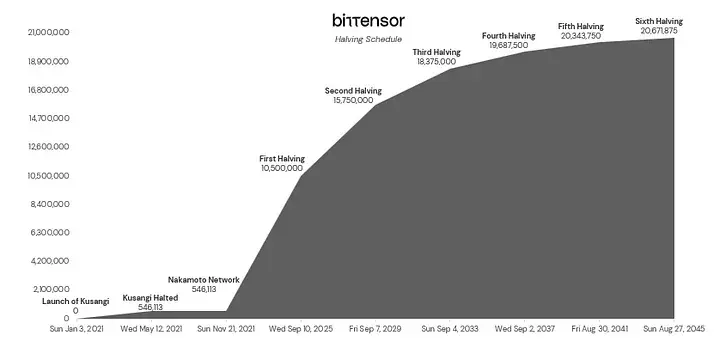
Value Capture of $TAO
$TAO is the native token of the Bittensor network, and its intrinsic value stems from its unique role within the ecosystem. Unlike network tokens that derive value from selling block space in the standard L1 model, the value of $TAO is linked to the AI services it supports. As these AI services become more influential and practical, the demand for $TAO increases.
Holding $TAO grants access to a range of interconnected digital resources, including data, bandwidth, and intelligence generated and verified by network participants. As reflected in the issuance schedule, the value of $TAO is rooted not only in speculation or scarcity but also in its tangible contributions and utility within the Bittensor network.
However, maintaining this cycle of creation and reward is not guaranteed. While miners and validators earn $TAO tokens as a reward for providing valuable intelligence to the network, they also have the motivation to sell tokens to cover expenses, similar to Bitcoin miners.
How Does Token Price Reflect Value?
Like any other token, the price of $TAO is determined by the fundamental economic principles of supply and demand. Increasing demand for $TAO leads to price appreciation, while decreasing demand leads to price depreciation. Therefore, the idea is that the demand generated by ecosystem activity will offset supply releases.
You can only acquire $TAO by contributing to the network. To do so, you need to purchase and hold it or spend it to start using the network.
- Demand-Driven Factors:
- Ecosystem Activity:
- Validators require $TAO tokens for registration.
- Users can purchase $TAO to participate in voting processes related to intelligence alignment.
- Used as a means of payment within the network.
- Staking and delegating $TAO to earn staking rewards. This helps counteract inflationary issuance.
- Speculative premium as a way to bet on the upward potential of the convergence of blockchain and disruptive technologies like artificial intelligence.
- Network effects generated by more developers entering the network and leveraging the potential of open-source models.
- Supply-Driven Factors:
- Inflationary emission reaching the total token issuance of 21,000,000.
- Miners and validators can sell $TAO tokens to cover operational expenses, similar to Bitcoin miners selling Bitcoin to offset costs.
As the network expands and more AI models and subnets are added, the potential for value capture also increases. The synergy between artificial intelligence and blockchain drives the growth of the network, creating a self-reinforcing cycle.
In this way, Bittensor embodies the principles of Metcalfe's Law, where the value of the network is proportional to the square of the number of connected users or nodes. As more participants join the network, the value it provides grows exponentially.
How to Capture Such Value
In Bittensor, validators are incentivized to acquire staking from token holders, which is crucial for their operations within the network. As a token holder, you can choose to delegate $TAO to various validators. The most common choice is the OpenTensor Foundation itself, which owns about 20% of the network.
Currently, validators distribute 82% of their rewards in the form of $TAO tokens to their delegators. Therefore, delegating $TAO tokens to validators presents an opportunity for token holders to earn staking rewards, helping protect users from potential dilution caused by inflationary issuance.
- Validator rewards currently stand at 22.45%
- Staking rewards currently stand at 18.41%
Risk/Reward and Time Horizon
When evaluating the risk/reward of allocating a portion of your investment portfolio to $TAO, it is important to understand what you are actually purchasing. For example, purchasing does not grant holders the right to receive any form of income in USD from network economic activity. Instead, you receive token issuance as a reward. As a token holder, you can delegate these issued tokens to a validator to earn an annual rate and increase your $TAO holdings.
The analogy of $TAO to Bitcoin is clear, but behind Bitcoin, there is a unique underlying story. No one can provide a satisfactory answer to what gives $BTC its value or why it has any form of value, leading the community to tribal wars between maximalists, "shitcoiners," and extremists.
In reality, the token economics of Bitcoin are straightforward: $BTC is used to incentivize miners to operate and maintain the network, resulting in existing holders being diluted (although they can become miners or, in the case of Bittensor, delegators). Therefore, holders of the token are not incentivized and do not receive any rewards from the underlying network.
However, for $BTC, there is an important factor to consider, which is scarcity. In fact, there will only ever be 21 million $BTC, making it unique. For $TAO, while its token economics are modeled after Bitcoin, there are still over 70% of tokens yet to be issued. This presents a dilemma for investors: do they value the decentralization of the network more, or the scarcity of the asset.
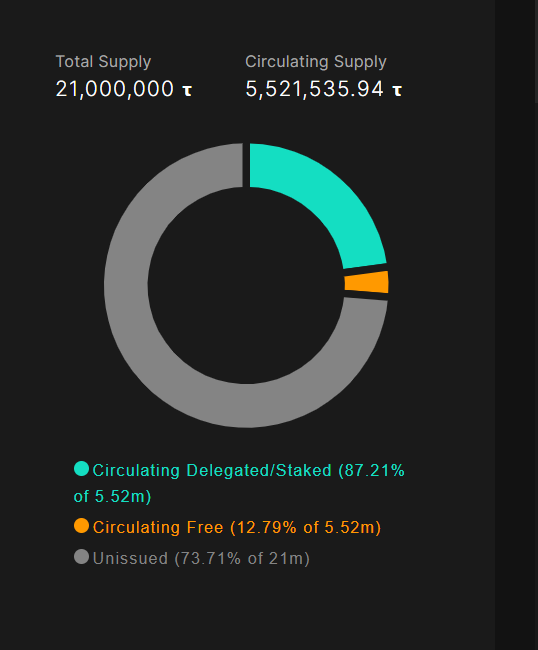
Ultimately, the utility of $TAO stems from its access to AI models, governance purposes, the opportunity to earn staking rewards, and as an incentive mechanism.
Operational Costs
The current infrastructure development costs are obtained through delegation and delegation rewards by the Opentensor Foundation. Other developments are carried out by third parties operating their own validation nodes, which are also funded through delegation.
Just as any global initiative requires funding for research, development, and deployment, the success of artificial intelligence depends on how capital is coordinated and how contributors' contributions are rewarded. It is this strategic allocation of resources (research, GPUs for training, etc.) that drives the development and impact of artificial intelligence.
In the field of artificial intelligence, especially for large language models like ChatGPT, operational costs are very high. For example, OpenAI estimates the daily operational cost of ChatGPT to be around $700,000, demonstrating the significant financial burden of large-scale AI models. The training cost for each model can range from millions to tens of millions of dollars, making it an even more resource-intensive endeavor. Training models on large datasets can incur even higher costs, up to $30 million. While the company has raised substantial funds, including recent investments from Microsoft (about half in the form of Azure credits), the continuously growing cost of training large language models remains a concerning issue. The cost of each training run is in the millions, exacerbating the issue of demand for new models from scratch.
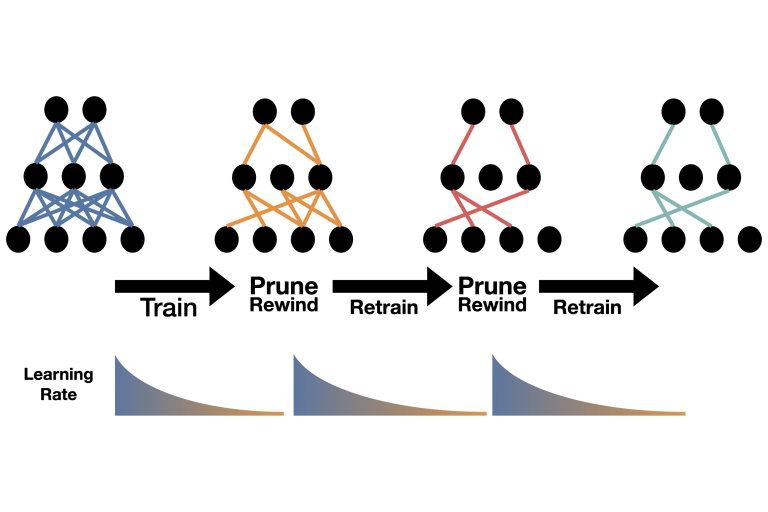
This is where the relevance of Bittensor's "knowledge composite" approach lies. Bittensor's unique approach focuses on achieving decentralization and collaboration through "knowledge composite." This concept enables AI systems to be built in a decentralized manner on existing knowledge, providing advantages such as:
Cost efficiency: By leveraging existing knowledge and continuously improving, Bittensor's approach is expected to reduce the need for expensive retraining from scratch.
Adaptability: Large-scale AI applications often face evolving demands and challenges. In this regard, the decentralized approach allows organizations to adjust their AI systems more flexibly, ensuring their relevance and effectiveness in dynamic environments.
Decentralization: Bittensor's decentralized network supports a global community of contributors, reducing reliance on a single entity or centralized infrastructure. This fosters innovation and diversity in AI development.
Collaboration: The collaborative nature of knowledge composite encourages knowledge sharing and cooperative learning among nodes in the network, creating a dynamic environment for AI advancement.
Team and Investors
Bittensor is an open-source protocol that supports decentralized, blockchain-based machine learning networks. The Bittensor team includes Jacob Steeves (Founder), Ala Shaabana (Founder), Jacqueline Dawn (Marketing Director), and Saeideh Motlagh (Blockchain Architect), among others. The Opentensor Foundation plans to expand their team this year.
The Bittensor whitepaper also mentions a pseudonymous figure named Yuma Rao, similar to Satoshi Nakamoto in Bitcoin. It is currently unclear whether this person actually exists, and we may never know more about him or her.
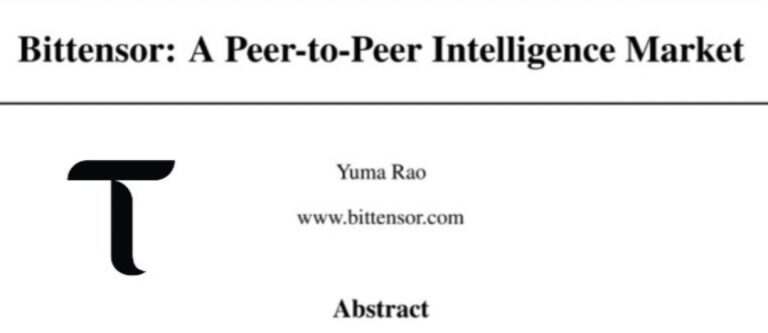
Bittensor has not disclosed any prominent advisors or key investors, apart from receiving funding support from the Opentensor Foundation, a non-profit organization supporting Bittensor's development. Bittensor has also not announced any official partnerships.
Perspectives
The valuations of most tech companies are far lower than their pre-pandemic valuations, but the multiples and growth rates of AI companies are currently at their highest levels.
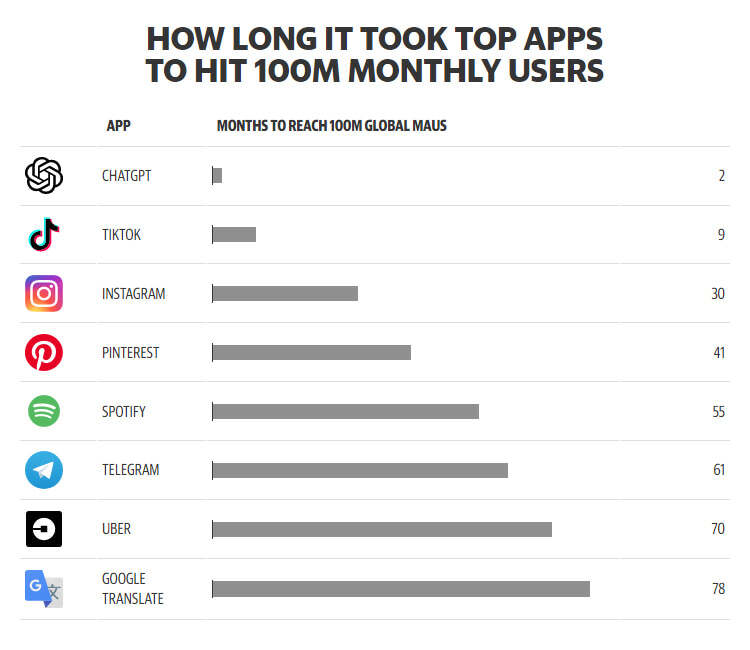
With a market value significantly lower than industry giants, Bittensor may indeed be an ideal platform for large-scale/high-demand AI applications and the use of open-source models.
Clearly, the simplest comparison to measure upside potential is to compare it with the private valuation of OpenAI, which stands at $29 billion. Regardless of the realism, this is roughly 28 times higher than the FDV of $TAO. Considering how long it will take for the entire supply to enter circulation, we can use the circulating market value to arrive at a rough figure of over 108 times the private valuation of OpenAI compared to the market value of $TAO. However, this is a highly speculative approach, simplifying the bet on projects that can benefit from the intersection of AI and crypto.
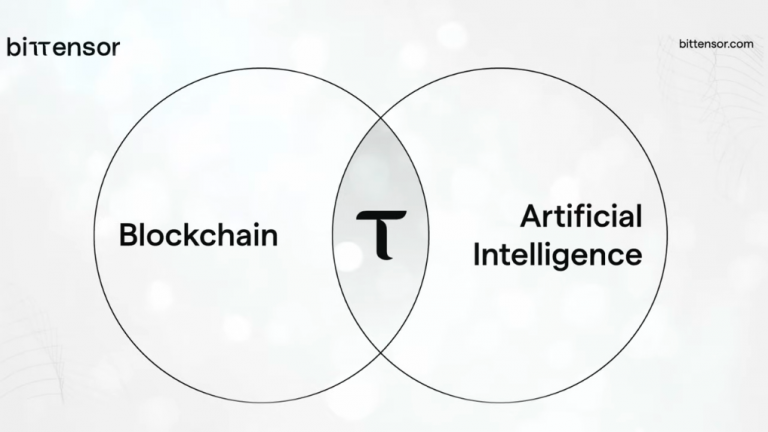
The most important feature of Bittensor is that it is addressing the centralization issue in AI. Currently, a few companies control a few large and powerful models, but they are isolated, with almost no collaboration or knowledge sharing.
Isolated AI models cannot learn from each other, making them non-compounding (researchers must start from scratch every time they create a new model). This contrasts sharply with AI research, where new researchers can build on the work of past researchers, creating a compounding effect that greatly advances the development of ideas.
Isolated AI is also limited in functionality, as third-party applications and data integration require the permission of the model owner (in the form of technical partnerships and business agreements). This limitation directly affects the value and utility of AI, as it can only operate within the scope of its effective support.
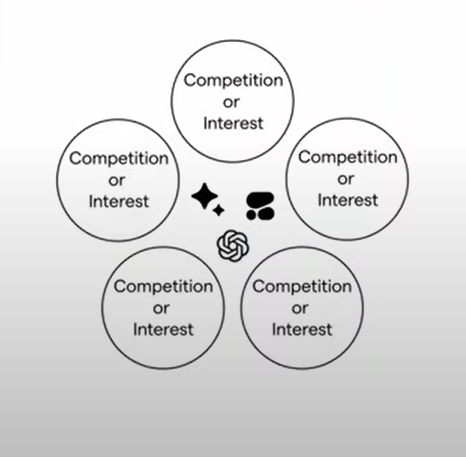
This centralized, winner-takes-all environment is not favorable for smaller teams with fewer resources. In this scenario, the core advantage of Bittensor lies in its decentralized network and incentive mechanism, encouraging small teams and researchers to monetize their work.
If Bittensor successfully narrows the performance gap with leading closed-source AI providers (such as GPT-4), it could become the preferred choice for developers, businesses, and researchers in the crypto and AI fields. Its open and collaborative nature makes it an attractive alternative to closed ecosystems, with the potential for significant adoption. Ultimately, the valuation of TAO can come from the utility of the network (economic activity built on it) or direct cash flow from the protocol.
As a utility token, $TAO requires access to the network. Therefore, its valuation can be derived from the economic utility built on it.
As a staking token, holders can delegate $TAO to validators and earn a portion of the network income.
We can also measure returns based on market share and multiple assumptions (which can also lead to unreliable predictions).
Since utility is more subjective and abstract, we can start with cash flow. Assuming the future machine learning market reaches a certain market size (see Precedence Research estimates in the image below), we can value the Bittensor network based on its potential market share and revenue doubling.
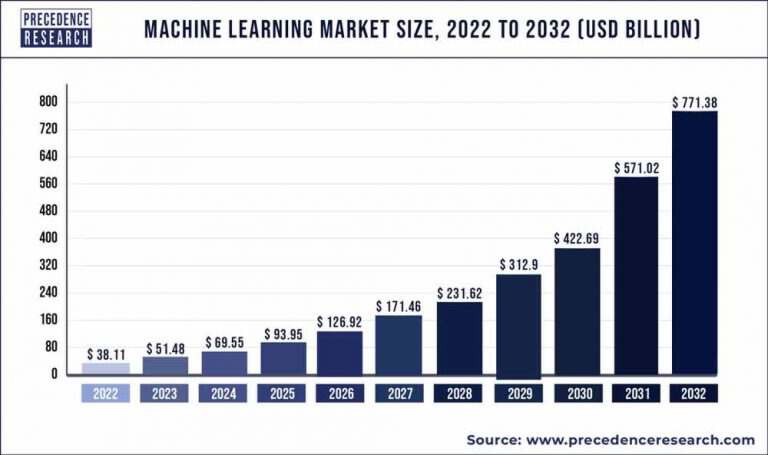
Regardless of the estimated market size, Bittensor remains a very professional and complex project, which is a barrier to easy entry for developers and adoption by users.
The project is still in the early stages of development, and the network may experience unexpected issues. For example, in June, there was collusion among miners that manipulated the network, leading to the dumping of $TAO in the market. The temporary solution was to reduce the supply by 90% to give the Opentensor Foundation additional time to address the network's issues and allow the protocol to operate as expected.
Most products currently running on the network are unable to compete with centralized counterparts and have had low adoption rates so far. The best way to understand and try it out personally is to test the services provided by Bittensor Hub.
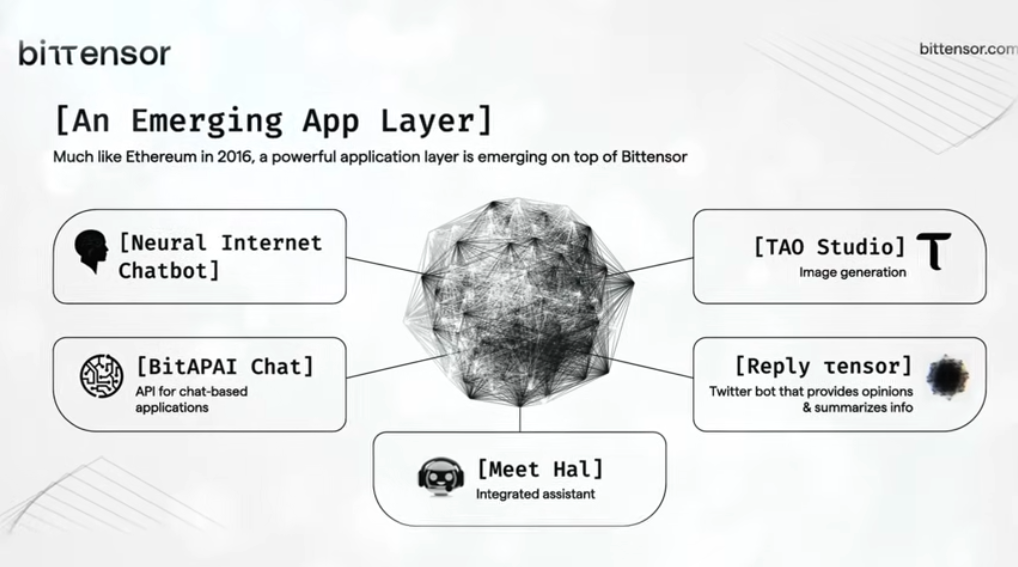
We should also ask the question of whether the token economics of Bitcoin are applicable to a network specifically providing artificial intelligence services like Bittensor. Perhaps the scarcity properties of $BTC are not suitable for a network that needs to expand with more miners and applications built on it. Ideally, the token should inflate with the growth of the network, more akin to digital oil than digital gold. To some extent, this is already built in, incentivizing miners to compete with each other and distributing the supply over 200+ years.
Another challenge is privacy, as it is not possible to encrypt data before it passes through a neural network. In a decentralized environment, this becomes even more tricky, as any data that goes through the learning and/or inference process is certainly not private. Of course, this could also be a potential issue in a centralized environment, but then you only have to worry about a known party seeing your data, rather than unknown multiple parties.
Economics

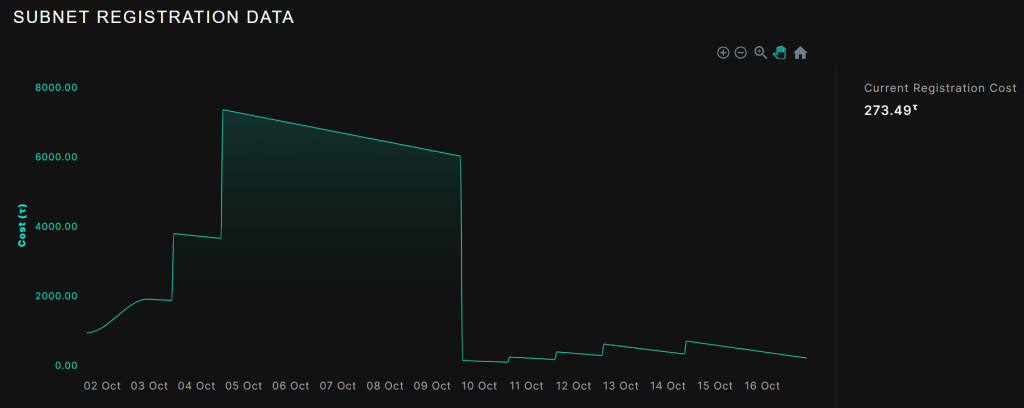
Token Price
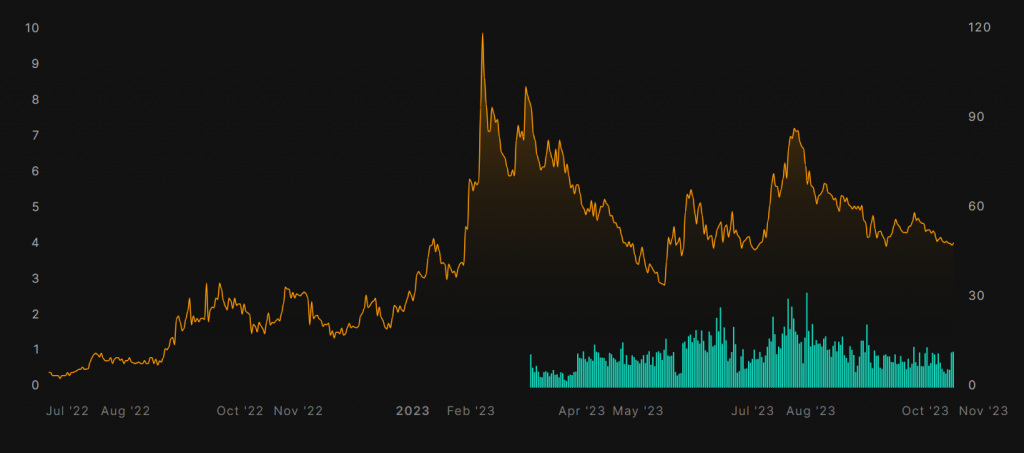
Price Relative to ATH and ATL
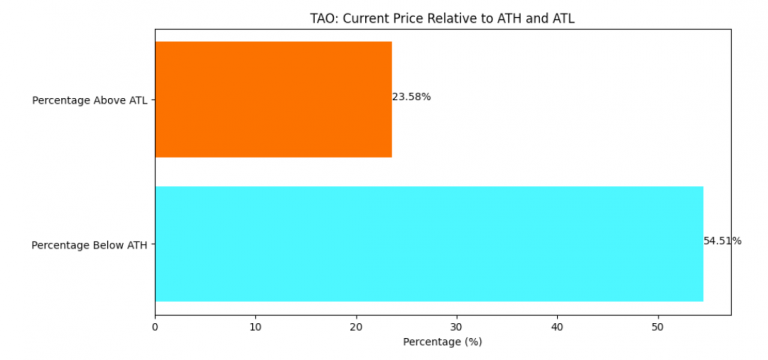
Supply Distribution
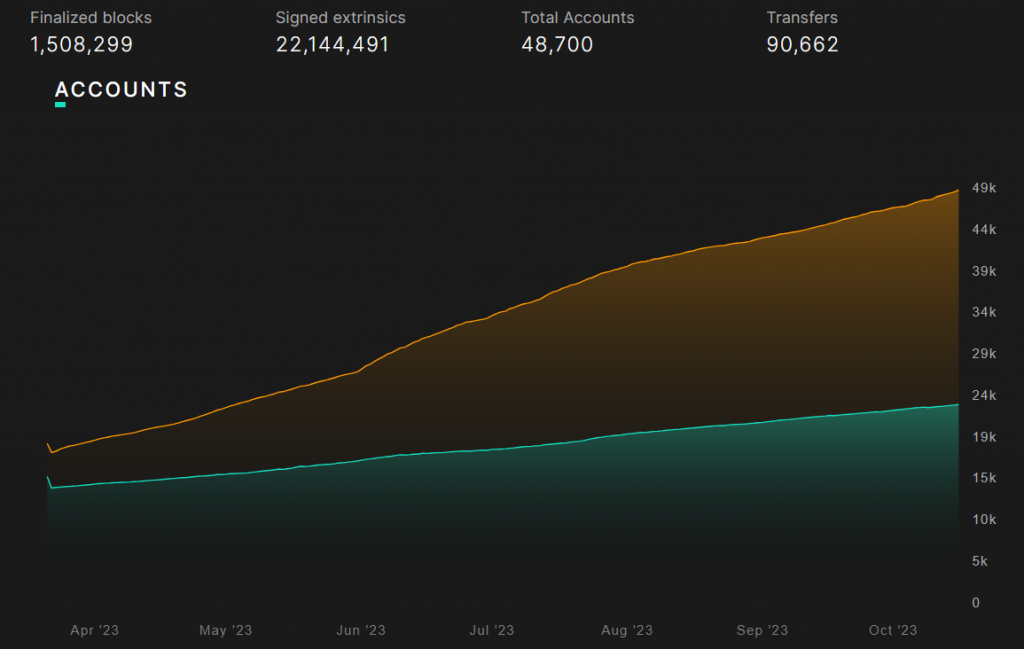
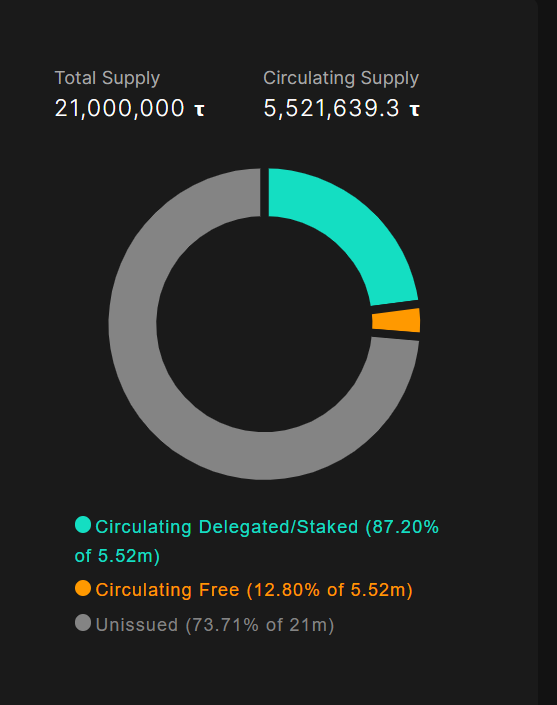
Conclusion
Bittensor may be a strong bet at the intersection of artificial intelligence and crypto. However, it is undoubtedly one of the most complex projects to evaluate in terms of its growth rate and potential upside. There is clearly significant potential in leveraging the utility of artificial intelligence in a decentralized network, especially in incentivizing open-source models and decentralized network ownership. However, the services and business cases built on top of Bittensor currently lack sufficient competitiveness.
Artificial intelligence is an industry that requires huge operational expenses and substantial financial support, achievable only by industry giants. In this sense, Bittensor is a very contrarian bet, which is why it's worth considering as many risk/reward factors as possible.
免责声明:本文章仅代表作者个人观点,不代表本平台的立场和观点。本文章仅供信息分享,不构成对任何人的任何投资建议。用户与作者之间的任何争议,与本平台无关。如网页中刊载的文章或图片涉及侵权,请提供相关的权利证明和身份证明发送邮件到support@aicoin.com,本平台相关工作人员将会进行核查。




